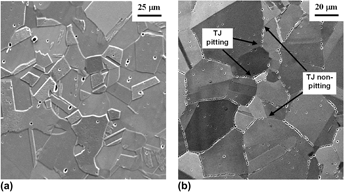Published online by Cambridge University Press: 17 June 2013

Type 304L stainless steel (SS) samples were used to investigate the correlation between carbide precipitation and triple junction structure derived from crystallographic data obtained by the orientation imaging microscopy associated with electron backscattered diffraction. The samples were solution treated and annealed at different sensitization temperatures/time to introduce various degrees of carbide precipitation at the interface region, thus different degrees of selectivity toward triple junctions. Four models were used to characterize triple junction microstructures: (i) the I-line and U-line model, (ii) the coincident axial direction (CAD) model, (iii) the coincident site lattice (CSL)/grain boundary (GB) model and (iv) the plane matching (PM)/GB model. Among them, the I-line and U-line model is the most effective in identifying special triple junctions, i.e., those exhibiting the beneficial property of high resistance to carbide precipitation. The results showed that the percentage of special triple junctions (I-lines) immune to carbide precipitation, increased from 35 to 80%, as the precipitation became more selective toward triple junction structures due to the corresponding sensitization heat treatment conditions, whereas more than 80% of random triple junctions (U-lines) exhibited susceptibility to carbide precipitation regardless of the sensitization conditions.